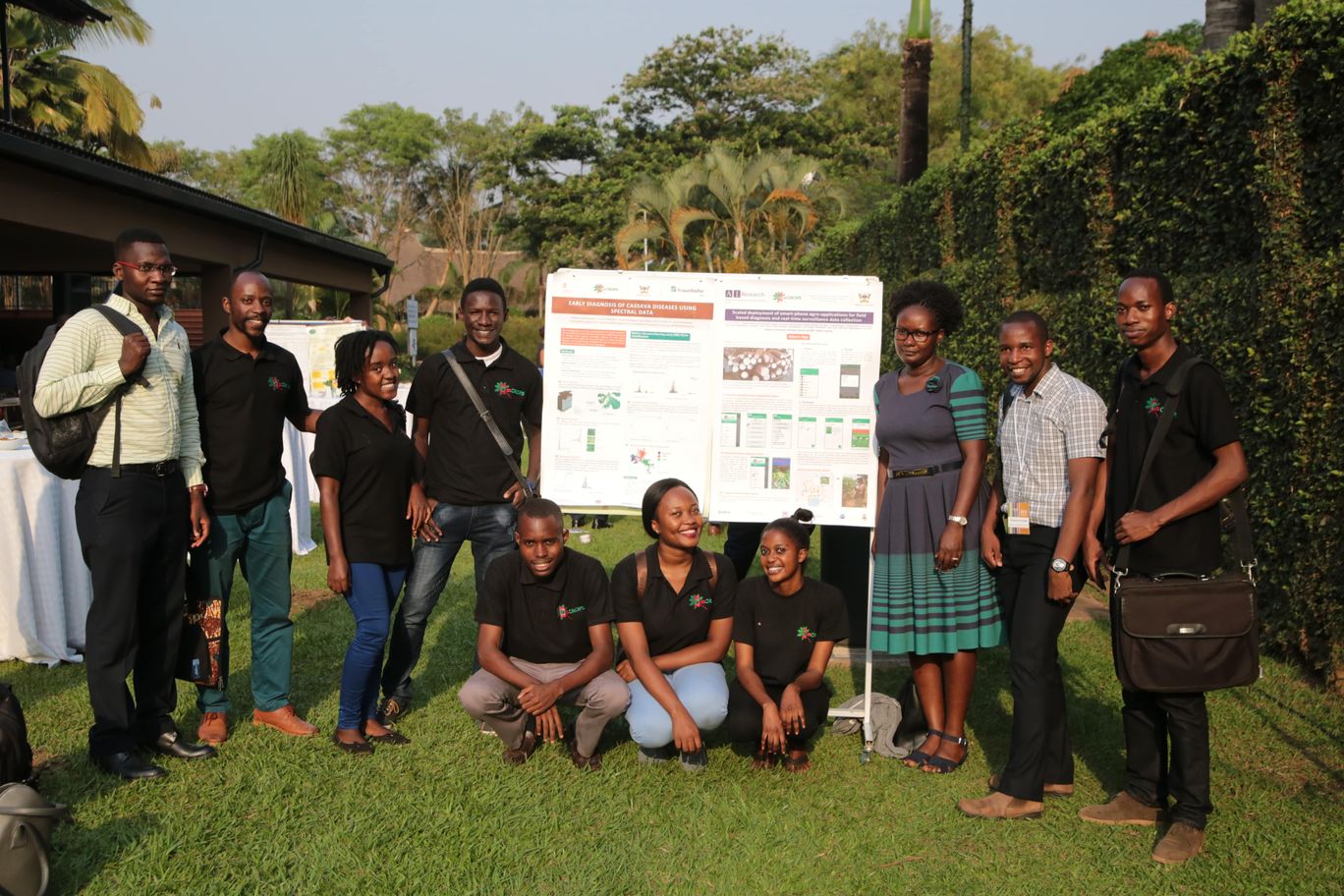An important aspect of the NextGen Cassava project is improving phenotyping techniques in the field for the rapid assessment of cassava roots, leaves, and disease monitoring. The Cassavabase team actively collaborates with the PhenoApps team in Jesse Poland’s lab at Kansas State University, and the Artificial Intelligence & Data Research (AIR) Lab at Makerere University in Uganda. These scientists work together to develop smartphone apps, algorithms, and novel techniques to accurately collect and store valuable breeding data. By partnering with these groups, the NextGen Cassava project is creating networks necessary for success. We spoke to Joyce Nabende, Research Scientist & Lecturer at the AIR Lab, to learn more about this key partnership.

The AIR Lab team at the 2019 NextGen Cassava annual meeting in Kampala, Uganda. Joyce is pictured to the right of the poster.
Can you describe how do you see the AIR Lab’s role in the NextGen Cassava project, and how this partnership came to be?
The AIR Lab’s role in the NextGen Cassava Project is developing imaging technologies for improving the phenotyping pipelines as well as monitoring the usage of PhenoApps to provide quantitative data on their efficacy. The NextGen project relies on data to improve the efficiency and effectiveness of breeding cycles in cassava. The AIR Lab contributes to this goal by building efficient and accurate phenotyping pipelines that feed into the NextGen Cassava data ecosystem.
In the past, we have carried out several research projects jointly with our partners at NaCRRI in Namulonge. NaCRRI is one of the breeding programs that the NextGen project supports, so the partnership with NextGen Cassava was fostered under the working relationship that we have established with the cassava program there.
Do you work with any Master’s/PhD students in the lab? What (generally) is their work focused on?
Currently, we are working on a new task to support Leah Nandudu (PhD student at Cornell University with Jean-Luc Jannink) in using image-based analysis methods for characterizing different expressions of root necrosis caused by cassava brown streak viruses.
Has the partnership/involvement with NextGen benefited the AIR Lab at Makerere University? In what ways?
AIR lab collaborations with NaCRRI in Namulonge and TARI in Tanzania have improved significantly since the lab is now directly working with the staff from these breeding programs that are also part of the NextGen Cassava project.
AIR lab has also strengthened its collaboration with the Mueller lab at the Boyce Thompson Institute, and this is good for the AIR Lab because we have other agriculture imaging tools we would like to have integrated with Cassavabase. With this good working relationship brought about by NextGen Cassava, such integrations are now a reality.
The partnership has led to working closely with the PhenoApps team at Kansas State University that developed the Fieldbook app, to this end we have managed to integrate our image analysis tools within FieldBook.
How does the NextGen project fit into the AIR Lab’s overall mission and goals?
AIR Lab’s mission is to advance artificial intelligence research to solve real-world challenges. The AIR lab has over the last couple of years honed its ability to derive actionable information from images using computer vision and machine learning techniques. The work that the AIR Lab is doing under the NextGen Cassava project to leverage its knowledge to improve phenotyping pipelines falls under our overall mission, and thereby improves the breeding efficiencies of cassava breeders.
How do you see NextGen Cassava and the AIR Lab’s partnership moving forward?
Moving forward, the AIR Lab will continue with the work we are doing under NextGen Cassava in Phase 2, in order to achieve our primary outcome of building breeding-support technological tools for supporting the collection, collation, processing and visualization of phenotypic data. This work will continue with the joint partnership with NaCRRI and TARI to ensure that the breeders are empowered to make quick and accurate breeding decisions, using our phenotypic tools.
What else is notable about the AIR Lab?
The AIR Lab is also contributing towards the implementation of The Breeding API (BrAPI) Project which is an effort to create a RESTful specification to enable interoperability among plant breeding databases.






